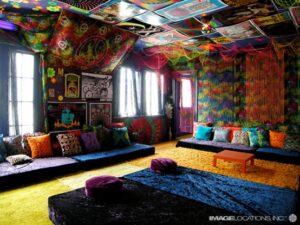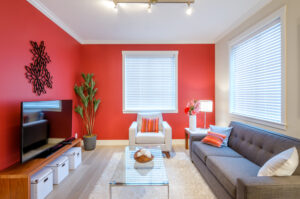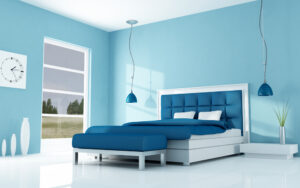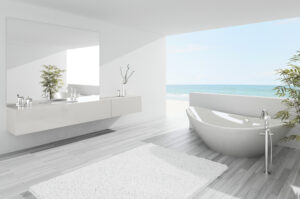The colours in our surroundings can have a tangible impact on our mood, emotions and personality. Have you ever noticed how your feelings might change when you enter a light blue room, versus a dark red one? There is a science to how colours affect us.

Every room in your house can introduce positivity and overall good vibrations- if they are painted with colours that evoke healthy responses.
To better understand which colours are most beneficial in which rooms, you must first identify the room’s primary function.
After you’ve decided if this room will be for relaxation, entertainment, or several other options, you can move on to choosing a colour that fits your personality and will create the space you desire.
I’m going to explain what rooms do better with which colours, and why.
Kitchen
The kitchen can be a lively room with lots of activity and movement, depending on how frequently you cook and how often you have guests. Colour analysts suggest painting your kitchen red, orange, or yellow.
The colour red is known to trigger the appetite. So, if you’re on a diet it’s probably best to avoid this one.
Orange is an energetic colour and helps to raise vibrations.
 Yellow is a great colour for smaller, open-spaced rooms. It brings joy and happiness, and reminds us of the warmth we feel from sunlight.
Yellow is a great colour for smaller, open-spaced rooms. It brings joy and happiness, and reminds us of the warmth we feel from sunlight.
Living Room
The living room is where people hang out, catch up, and where most entertainment takes place.
It is those qualities of the room that leads colour experts to recommend red and orange, because they are thought to stimulate social interaction and lively behaviour.
Bedroom
Bedrooms are where most people want to reflect tranquility and peace. Blue, green, and light purple are thought to be the best choices for ensuring a good night’s rest, and a pleasant start to your morning.
Blue is believed to help reduce blood pressure, and promote serenity. A very calming colour, blue in all it’s shades can help you relax.
Green promotes calmness as well, and is the most restful colour to the eye. If you’re planning on having a child one day, remember that green is believed to help with fertility.
Lilac, lavender, or any other shade of light purple has similar effects to blue- both are relaxing, peaceful colours.
It should be noted to avoid the colour yellow in bedrooms. Yellow in a bedroom can cause stress, anger and frustration.
Bathroom
Usually people are drawn to white, or shades of other colours light enough to be close to white. This is because white reflects the idea of cleanliness and purity. Other colours that do well in this small space are spa shades- turquoise, light blue, light yellow, light green.
 Turquoise is thought to make you feel protected and secure, as well as calm.
Turquoise is thought to make you feel protected and secure, as well as calm.
Light blue and light green are reminders of “freshness” and clarity.
Light yellow can brighten up a small bathroom with little light available.
Obviously everyone has their own personality and taste when it comes to decorating. For example, my house is anything but practical. We all have an inner-decorator with ideas that some may find completely wild, but it doesn’t matter.
Go for what makes you feel good, and what you are comfortable with. There are no rules, just guides.
“Life is indeed colourful. We can feel in the pink one day, with our bank balances comfortably in the black, and the grass seemingly no greener on the other side of the fence. Then out of the blue, something tiresome happens that makes us see red, turn ashen white, even purple with rage. Maybe controlling our varying emotions is just ‘colour management’ by another name.”
– Alex Morritt, Impromptu Scribe
By Raven Fon

